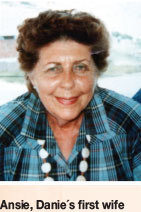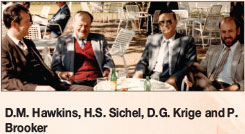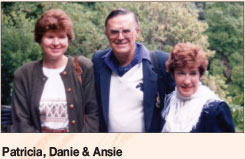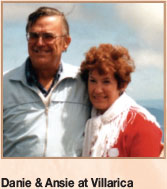Services on Demand
Article
Indicators
Related links
-
 Cited by Google
Cited by Google -
 Similars in Google
Similars in Google
Share
Journal of the Southern African Institute of Mining and Metallurgy
On-line version ISSN 2411-9717
Print version ISSN 2225-6253
J. S. Afr. Inst. Min. Metall. vol.114 n.8 Johannesburg Aug. 2014
SPECIAL ARTICLES
Memories of Danie Krige - Geostatistician Extraordinaire
Let me start the story in 1969, when I was a final-year mining engineering student at the University of Chile. At that time, Andre Journel, a young man from the Paris School of Mines (Fontainebleau), came to Chile to teach a two or three months-long seminar on geostatistics. If I am not mistaken, that was the very start of geostatistics in Chile. This effort was continued in the early 70's by Andre's colleague Alain Merechal. In those days, geostatistics was highly mathematical and theoretical, as commercial software did not exist and enthusiastic users had to write their own code. It is not surprising that geostatistics in Chile had a distinct French flavor and Kriging was referred to as 'Krigeage'. In my ignorance, I grew up thinking that Daniel Krige was a very clever Frenchman.

I had no further contact with geostatistics until 1975. At that time, I was working for Anglo American Corporation in Welkom, South Africa, in the Management Sciences Department, developing mixed integer programming models for mine planning. Of course, the gold grades assigned to the different mining areas had a large impact on the sequencing, as well as on the expected profits. My esteemed friends, the geologists, had the almost impossible task of predicting the gold and uranium grades of large blocks, based on perhaps half a dozen boreholes covering an area as large as 50 km2. On the other hand, closely spaced underground sampling showed large variability and intricate grade patterns. Grade predictions based on a very limited number of drill hole results seemed almost impossible. This is what started my interest in the subject.
At that time, publications were few - many of them in French, with at least 50 integrals per page. It was not easy! I admit I was battling to get to grips with the subject. One fine day, my boss said 'Why don't you go and see Danie Krige, perhaps he can give you a hand'. Immediately I replied 'Great, I'm off to France'. 'I'm afraid not, Danie works for Anglovaal in Johannesburg, so just get in your car', came the reply.

I visited Danie every three or four months. He introduced me to his co-worker, Jean-Michel Rendu. They were extremely helpful and shared their knowledge, papers and lots of advice. During one visit, Danie explained that he was rather sad since Jean-Michel had accepted and offer as Professor at a prestigious University in the USA. Before returning to Welkom that evening, I walked into Danie's office and said to him 'What about the job, then?' I thought to myself that I was being rather cheeky. To my great surprise Danie said 'If you want the job, it is all yours'. I was delighted and could not wait to get home and tell my wife Patricia the great news.
I joined Anglovaal in 1976 and worked with Danie for 10 years. Danie was a patient boss and explained the famous log-normal regression model - the first steps towards kriging - on more than one occasion.

In the early 80's, we gave four one-week courses at the University of Clausthal-Zellerfeld in Germany. On one of these occasions, our wives Ansie and Patricia accompanied us. We stayed in the silver-mining medieval town of Goslar, in Lower Saxony, close to the beautiful Harz Mountains. The hotel was close to the central square, housed in a thousand year-old building. In the evenings, after classes, we would sit in a quaint little coffee shop on the square, enjoying coffee with wonderful pastries and listening to the Town Hall 'glockenspiel'.

For a weekend, we visited Berlin and took a bus tour to East Berlin. We crossed the wall at Check Point Charlie. A uniformed lady, who looked and acted as if she were a member of the Gestapo, boarded the bus, checked all the passports and returned them to each passenger, except Danie's and mine. She took our passports into an office and stayed there for about 20 minutes. The other passengers were all muttering in German and looking at us. We had a quiet chat with Danie: 'We are going to be famous; you coming from the land of apartheid and me from General Pinochet's dictatorship. We might be here for a long, long time'. In the end the police woman came back, gave us our passports with a dour look and the tour continued normally.

Unfortunately, Ansie suffered from severe asthma and passed away in 1989. We remember her as a very kind and loving person. Some years later, Danie married a wonderful lady, co-incidentally also named Ansie.

South Africa has produced a number of great statisticians. On one occasion, we had lunch at the Johannesburg Club with Danie, D.M. Hawkins, H.S. Sichel and Peter Brooker from the UK. In my modest opinion, having had the honour and the pleasure of working with some of these great minds, they all seemed to have something in common: they are all unassuming, approachable, helpful and always willing to share their knowledge. It seems to be the mark of truly great people.
I remember those 10 years I worked at Anglovaal with Danie as very happy, friendly and productive. The company and Danie were very special and encouraged research, conferences, publications and teaching part time at the Mining Engineering Department of the University of the Witwatersrand. We developed a fine working relationship with my favorite clients and lifelong friends, the geologists; in particular with Jan Mostert.

In 1986, due mainly to family pressures, we moved back to Chile, where I have been working as a part time Professor at the University of Chile and as a mining consultant in geostatistics and sampling ever since. Over the years in Chile, our working relationship with Danie continued and we presented some short courses together, met at conferences and seminars and completed ore resource calculation reviews for several large Chilean copper mines. On one occasion, Danie was accompanied by Ansie and we went on holiday to the beautiful Chilean Lake District, some 900 km south of Santiago. On the way south, I got a speeding fine. A few kilometers further, another policeman stopped me for yet another traffic offence. Ansie could not bear it, got out of the car and gave the policeman a dressing-down in English. To our great surprise, he let us go, remarking that my driving was not at all brilliant that day.

Some years ago, I was teaching the undergraduate course on linear geostatistics to the mining engineering students. We had covered the estimation variance material and had still to continue with Kriging. By coincidence, Danie was in Chile and I asked him if he would be so kind as to give the Kriging lecture himself. Typical of Danie, he immediately accepted. As we walked into the class, there was silence. I told the students that the next topic was Kriging and the best person to present the subject was none other than Professor Krige himself. You should have seen the look on their faces......... That evening, the students came to our home to socialize and enjoy a few drinks with Danie. They took many photos and had a wonderful time with Ansie and Danie.

In 2007, I chaired APCOM in Chile. Danie very kindly delivered the opening keynote address with Clayton Deutsch on 'The Origins and Future of Geostatistics'. The conference went very well and many people almost queued to have their pictures taken with Danie. As a keepsake, I still have a bottle of good Chilean wine with Danie's signature on the label.
In July 2007, we went on safari to Tanzania with our dear friends Jeanne and Jan Mostert. On our return to Johannesburg, Ansie and Danie invited us for dinner at their home. We had a very pleasant, friendly evening. That was the last time we saw Danie.
Through the years, I lost track of the number of well-deserved Honorary Doctorates and distinctions that Danie received. A concept that was started off by comparing estimated block values against follow up mining values (true block values) in the South African Gold Mines has developed into a global industry with perhaps thousands of users in mining and other applications, by software developers and researchers all around the world. Danie's seed idea was picked up by research centers such as Fontainebleau, Stanford, Alberta, at various centers in South Africa and more recently in Chile, and numerous new applications are continually being proposed and developed. An aspect perhaps less known was Danie's extensive knowledge and ability in subjects such as taxation and financial evaluation of mining projects. In fact, his company designation was that of Financial Engineer.
While travelling through Patagonia in early March, 2013, we received a message from Oskar Steffen saying that after an illness, Danie had passed away on Saturday March 2. It was a long, sad day.
Danie was my friend, my mentor. We remember him with great fondness and respect.
E. Magri














